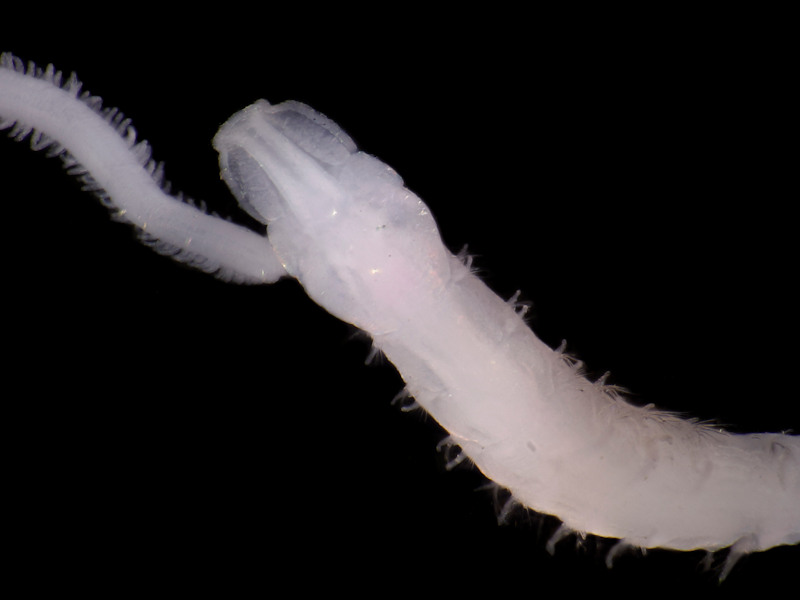A bristleworm (Magelona filiformis)
Distribution data supplied by the Ocean Biodiversity Information System (OBIS). To interrogate UK data visit the NBN Atlas.Map Help
| Researched by | Katie Mortimer-Jones | Refereed by | Admin |
| Authority | Wilson, 1959 | ||
| Other common names | - | Synonyms | - |
Summary
Description
Magelona filiformis is a thin, thread-like segmented worm that reaches lengths of up to 8-10 cm and is generally colourless (mature females may be more pinkish, whilst mature males are generally white). The body is divided into a head region (prostomium and peristomium), the thorax (first segment of which lacks chaetae or parapodia, and nine chaetigers, bearing chaetae and parapodia) and an abdomen of approximately 130-140 segments, terminating in the pygidium. The flattened, shovel-shaped prostomium (utilised to dig in soft sediments) is squared, and formed into small horn-like structures at the upper edge. An oval to heart-shaped burrowing organ may be everted underneath the prostomium and a pair of palps bearing two rows of papillae, attached either side of the mouth, used in feeding. On either side of the thoracic chaetigers, there is a slender finger-like lobe (with an additional small process sticking upwards) dorsally, and a slender lobe ventrally, with approximately 15 dorsal and 10 ventral chaetae. The ninth chaetiger, which divides the thorax and abdomen, bears finger-like lobes dorsally and ventrally with an additional small lobe below the ventral chaetae. There are approximately 25-30 chaetae in both rami (notopodia and neuropodia) for this chaetiger. Abdominal segments each bear notopodial and neuropodial lobes that are more foliose than those in the thoracic region. A row of hooded hooks is present, terminating in a short cirrus in both rami. Towards the posterior abdomen the neuropodia and notopodia are positioned increasingly toward the posterior end of each segment. The most posterior end of the body is tapered into a pygidium bearing two small anal cirri.
Recorded distribution in Britain and Ireland
Magelona filiformis is widespread on the coasts of Britain and Northern Ireland.Global distribution
-Habitat
Magelona filiformis forms fragile tubles in clean to muddy sand on the lower shore.Depth range
-Identifying features
- Long, thread-like body of approximately 140 segments.
- Body grows up to 5-10 cm.
- Flattened head region with small ‘horns’.
- Long, slender tentacles (palps) either side of head bearing two rows of papillae.
- Burrowing organ globular-shaped when everted.
- Eyes absent.
- Ninth thoracic chaetiger similar to preceding segments, but without dorsal process, however, an additional ventral lobe is present each side.
- Thorax with chaetal bundles, and abdomen with hooded hooks.
Additional information
No text enteredListed by
- none -
Bibliography
Costello, M.J., Bouchet, P., Boxshall, G., Emblow, C. & Vanden Berghe, E., 2004. European Register of Marine Species [On-line]. http://www.marbef.org/data/erms.php,
Fauchald, K., & Rouse, G. 1997. Polychaete systematics: past and present. Zoologica Scripta, 26(2), 71-138.
Fiege, D., Licher, F. & Mackie, A.S.Y., 2000. A partial review of the European Magelonidae (Annelida : Polychaeta) Magelona mirabilis redefined and M. johnstoni sp. nov. distinguished. Journal of the Marine Biological Association of the United Kingdom, 80, 215-234.
Foster-Smith, J. (ed.), 2000. The marine fauna and flora of the Cullercoats District. Marine species records for the North East Coast of England. Sunderland: Penshaw Press, for the Dove Marine Laboratory, University of Newcastle upon Tyne.
Howson, C.M. & Picton, B.E., 1997. The species directory of the marine fauna and flora of the British Isles and surrounding seas. Belfast: Ulster Museum. [Ulster Museum publication, no. 276.]
Mortimer, K., 2017. Magelonidae Cunningham & Ramage, 1888. In Purschke G & Westheide W (eds), Handbook of Zoology (Online). Berlin: De Gruyter. https://www.degruyter.com/view/Zoology/bp_029147-6_65.
Picton, B.E. & Costello, M.J., 1998. BioMar biotope viewer: a guide to marine habitats, fauna and flora of Britain and Ireland. [CD-ROM] Environmental Sciences Unit, Trinity College, Dublin.
Wilson, D.P., 1959. The polychaete Magelona filiformis sp.nov. and notes on other species of Magelona. Journal of the Marine Biological Association of the United Kingdom, 38(3), 547-556.
Datasets
NBN (National Biodiversity Network) Atlas. Available from: https://www.nbnatlas.org.
OBIS (Ocean Biodiversity Information System), 2025. Global map of species distribution using gridded data. Available from: Ocean Biogeographic Information System. www.iobis.org. Accessed: 2025-08-08
South East Wales Biodiversity Records Centre, 2018. SEWBReC Worms (South East Wales). Occurrence dataset: https://doi.org/10.15468/5vh0w8 accessed via GBIF.org on 2018-10-02.
Citation
This review can be cited as:
Last Updated: 12/09/2007




